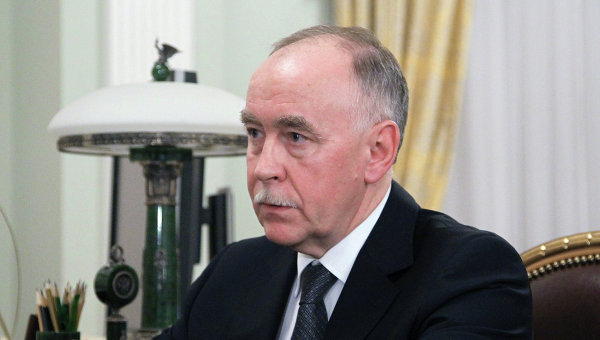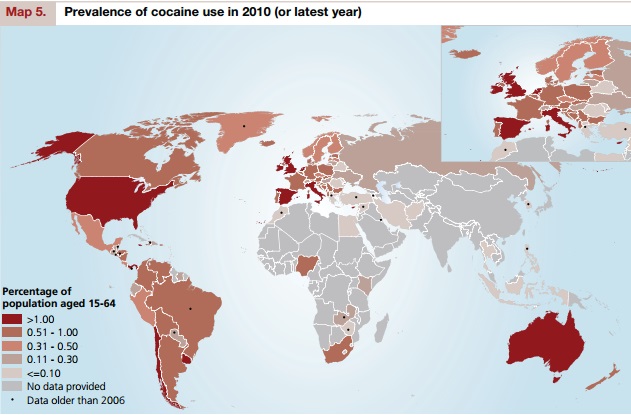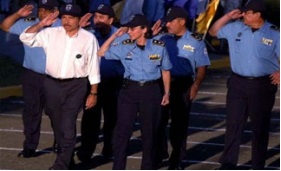Russia and Nicaragua: Working Together To Foil International Drug Trafficking

On March 19, 2013, the Director of Federal Drug Control Service (FDCS) of the Russian Federation, Viktor Ivanov, arrived in Nicaragua to encourage the development of deeper cooperation in curbing drug trafficking. During his visit, Ivanov participated in the groundbreaking ceremony for laying the foundation of a new regional counter-drug law enforcement training center that will be located in Managua and financed by Moscow. [1] The institution will provide specialized training not only for Nicaraguan police officers, but also for participants from neighboring countries. Managua officials are also looking into the possible repercussions of this partnership with Washington.
Nicaragua Facility as a Drug Trafficking Tool
Nicaragua is located at a dangerous crossroad between some of the largest producers of drugs–Bolivia, Colombia, Peru, and the United States (the largest user). The 2012 World Drug Report, published by the United Nations Office on Drugs and Crime, notes that cocaine from South America is shipped along this route by boats or semi-submarines, heading through the Central American corridor and then overland to the United States. [2] The Central Intelligence Agency also acknowledges this fact, describing Nicaragua as a “transshipment point for cocaine destined to the United States and transshipment point for arms-for-drugs dealing.” [3]

Nicaragua offers a geographical advantage for transportation of illegal drugs, given its access to both the Pacific and Atlantic oceans. Moreover, the country’s 565 miles of coastline facilitates the entry of illegal products to the country. [4] The transfer usually occurs using old fishing boats, as they go largely unnoticed. [5]
According to a 2010 report published by the InSight Crime, Nicaragua was one of the main drug trafficking nations in Latin America, on par with Costa Rica and Honduras. Moreover, it has been reported that international cartels, such as Cartel de Sinaloa, Los Zetas, and Cartel del Valle de Colombia operate in Nicaragua. [6] The most recent evidence came from the breaking up of an illegal drug group operating in Nicaragua, directly connected to the Mexican cartel Los Zetas. [7]
Managua had responded to increased evidence of drug trafficking, with the creation of security patrols and by working to build local community trust throughout the region. Working directly with the local communities, security patrols form solid relationships with citizens and committed security forces. [8] The Nicaraguan police can now rely on the assistance of about 100,000 volunteers, who participate in mentoring and mediating activities. The trust was developed through direct participation of the community groups. Teams of volunteers, including many law and psychology students, take understandable pride in using self-reliance to help curb drug violence. The Gallup Poll in Latin America reported that citizens in Nicaragua have the highest level of trust and confidence in the military and police of any Latin American nation monitored. [9]

Nicaragua has not experienced the same level of violence and crime as suffered by “North Triangle” countries (Honduras, El Salvador, and Guatemala). Nevertheless, the danger remains of a “spill-over” of the violence from neighboring countries. [10] According to The Economist, the homicide rate in “North Triangle” countries ranges between 50 and 80 murders per 100,000 habitants, compared to the homicide rate in Nicaragua that is as low as 13 murders per 100,000 habitants. [11] Still, the potential for violence is real. Some 70 percent of the three million weapons in the country are illegal.
Nicaragua’s International Connections
Historically, Nicaragua has successfully resisted any major international influence or interference in its anti-drug trafficking efforts. Back in 2007, Nicaraguan President José Daniel Ortega Saavedra declared his strong preference for only using Nicaraguan troops in the drug war, and he firmly opposed any international participation or interference in what he considered to be a Nicaraguan matter. [12] Ortega observed that, “you have to be careful with the DEA. You can’t be blind.” Ortega pointed explicitly to the problematical nature of the U.S. Drug Enforcement Administration (DEA). [13]
Therefore, it came as a surprise when during the XII Summit of the Tuxtla Mechanism of Dialogue and Agreement in Yucatán, Mexico, on December 5, 2011, Ortega asked the international community for assistance with his country’s drug war. In particular, he requested that the United States and European nations increase their commitment to curb their demand for narcotics, track arms, and chemical sales and to contribute financially to anti-drug efforts as part of a “joint responsibility.” [14] Russia answered the Nicaraguan call for help, expressing its willingness to invest large sums in the fight against drug-related crimes in Nicaragua.
Bilateral Cooperation between Russia and Nicaragua
Russian-Nicaraguan cooperation began in the 1970s, when Sandinistas gained power in Nicaragua. From 1979 to 1990, the Sandinistas held power in the country, and Nicaragua became an important asset to the Soviet Union. In the 1990s after the dissolution of the Soviet Union and their loss in the 1989 presidential elections, the Sandinistas became entrenched in power, and Russia eventually closed its embassy in Managua. [15]
However, beginning in November 2008, bilateral relations improved when Russian President Medvedev met with Nicaraguan President Ortega during the Bolivarian Alliance for the Americas (ALBA) conference in Caracas, Venezuela. After several more meetings, Russia forgave Nicaragua its $3 billion USD debt dating back to the Soviet era. [16] The cooperation deepened in 2009 when Russia gave two modern helicopters to the Nicaraguan military free of charge. In addition, in June 2010, President Medvedev awarded Nicaragua with a “non-reimbursable financial assistance” package totaling $10 million USD. [17]
The most recent visit by Viktor Ivanov, the director of the FDCS, took place in late March 2013. The Russian “Drug Czar” first stopped in Peru to reassure its government of the seriousness of Russian participation and future assistance in fighting drug crime in the region. Then, from March 19 to March 22, Ivanov stayed in Nicaragua, where he opened a new regional anti-drug law enforcement training center in Managua. The Director of the FDCS announced that Russia would continue to assist its partners in Latin America in fighting organized drug crime. Moreover, Ivanov said that he had the opportunity to join the 32nd Extraordinary Meeting of the Commission of the Chiefs of Police of Central America, Mexico, the Caribbean, and Colombia. [18] The event gave Russia even greater access to expand its cooperation and presence in the region.
The relationship between the governments of Nicaragua and Russia resulted in breaking up a powerful drug ring that was supplying the European and Russian illegal markets. On March 12, 2013, Ivanov announced that the secret service of both Nicaragua and Russia had successfully closed down the drug network led by Martin Flores, one of the main members of the Mexican cartel, Los Zetas. This cartel was directly involved in supplying Russia with illegal drugs and had employed Russian citizens in its activities. [19] Through the “Operation Temis” as it was called, both governments managed to recover cash in Mexican pesos and in U.S. dollars, along with several trucks and stores of high-powered weapons. [20]
The United States and Nicaragua
The United States and Nicaragua have had a long shared history and collaboration in the war on illegal drugs. The United States established the DEA office in Managua back in October 1997, and it is considered by many experts to be the most successful one in Central America. From 2008 to 2013, the U.S. government disbursed $27.8 million USD in military assistance to Nicaragua. [21] In the last 10 years, the Nicaraguan national police and military have seized 105 tons of drugs, 25 airplanes, and 50 boats. [22]
Some in the United States may be troubled by the rising Russian presence in the region. Voicing concern, the U.S. Ambassador in Managua Phyllis Powers underscored that the Russian counter-narcotic assistance to Central America was just a complementary collaboration to the work of the DEA in the country. [23] The U.S. ambassador emphasized that Russian assistance would not replace the DEA’s work. Powers confirmed, “Joint [U.S.] operations with the Central American countries in international waters will continue.” [24]
Not wishing to be seen as being outdone by the Russians, the White House announced on March 27 that President Obama will visit Mexico and Central America this May. [25] Obama will stop in Costa Rica, where he will have a chance to meet with the country’s president as well as the heads of state of the other Central American nations. According to the official White House statement, the president will have a chance to reaffirm U.S. ongoing collaboration and contribution to public’s security. [26] Regarding trade collaboration, Nicaragua maintains a stable relationship with the United States, since this country is the main destination for Nicaragua’s total exports (30.4 million USD a year). [27] This represents an important contrast to Russian trade relations with Nicaragua. According to the Nicaraguan Minister of Development, Industry, and Trade Orlando Solorzano, little is imported. Last year, sales to Russia totaled $15.7 million USD and so far in 2013 only $2.3 million USD has been invested in Nicaragua. [28]
The Balance between Russia and the United States
There is no denying that Nicaragua needs strong outside partners in fighting the violence associated with illegal drug trafficking. Historical ties with Russia create a deep well of understanding between both governments. Nevertheless, in a situation where Russia, a country outside of the Western Hemisphere, is engaged in growing relations with a Latin American state, especially in the area of military cooperation, some suspicions may arise regarding the nature of its true intentions.
Nicaragua is hesitant about choosing a single long-term partner in its fight against drug trafficking. The country is planning to diversify its sources of financial and training assistance. President Ortega is certainly cautious about denying the influence of the United States in his country, as it could possibly intensify the pattern of economic competition as well as cooperation, especially considering the importance of the U.S. market and its potential for Russian-Nicaragua trade in the future. Nevertheless, Russian assistance to Nicaragua is being viewed as a mutually beneficial matter. For Russia, this is evidence of its rebirth as a diplomatic force in Latin America and is a signal that Moscow is prepared to fight narco-trafficking drugs; Nicaraguans are using the situation to obtain an upper hand in its anti-drug trafficking efforts.
Please accept this article as a free contribution from COHA, but if re-posting, please afford authorial and institutional attribution. Exclusive rights can be negotiated.
For additional news or analysis on Latin America, please go to: Latin News
_____________________
References
[1] “Russia Looks to Expand Anti-Drug Efforts in South America,” Ria Novosti, March 26, 2013, http://en.rian.ru/russia/20130326/180262004.html.
[2] World Drug 2012 Report, United Nations Office on Drugs and Crime, June 2012, https://www.unodc.org/documents/data-and-analysis/WDR2012/WDR_2012_web_small.pdf.
[3] Nicaragua, The World Factbook, CIA, https://www.cia.gov/library/publications/the-world-factbook/fields/2086.html.
[4] Ibid.
[5] Nicaragua, InSight Crime, http://es.insightcrime.org/perfil-del-crimen-organizado/nicaragua#geografia.
[6] Ibid.
[7] “Russia Nicaragua Bust Drug Cartel,” RiaNovosti, March 11, 2013, http://en.rian.ru/world/20130311/179946683.html.
[8] Nicaragua, InSight Crime, http://es.insightcrime.org/perfil-del-crimen-organizado/nicaragua.
[9] “Encuesta de Opinión Publica Centro américa y República Dominicana,” CID-Gallup, February 2013, http://www.cidgallup.com/Documentos/LOS%20CENTROAMERICANOS%20SE%20PREOCUPAN%20M%C3%81S%20POR%20EL%20CRIMEN%20CALLEJERO.pdf.
[10] Nicaragua, InSight Crime, http://es.insightcrime.org/perfil-del-crimen-organizado/nicaragua.
[11] “Crime in Nicaragua, A surprising safe haven,” The Economist, January 28, 2012, http://www.economist.com/node/21543492.
[12] Smith, Philip, “Latin America: Nicaraguan President Warns of DEA’s ‘Unexpected Interests’ and ‘Terrible Things’ Stop the Drug War, August 16, 2007, http://stopthedrugwar.org/chronicle/2007/aug/16/latin_america_nicaraguan_preside.
[13] Ibid.
[14] Ramos, Jorge and Yazmín Rodriguez, “Destaca Presidencia logros de Cumbre de Mérida,” El Universal, Decemeber 5, 2011, http://www.eluniversal.com.mx/notas/814014.html.
[15] “Respublika Nikaragua i ee otnosheniya s Rossiyey Spravka”, RiaNovosti, December 18, 2008, http://ria.ru/politics/20081218/157503194.html.
[16] Ibid.
[17] “Report on the visit to Peru and Nicaragua,” 10п em CФ H Poccuu, Federal Drug Сontrol Service, March 23, 2013, http://www.fskn.gov.ru/includes/periodics/international/2013/0323/103122960/detail.shtml.
[18] “Desmantelan red Zeta que traficaba droga a Rusia,” El Universal, March 12, 2013, http://www.eluniversal.com.mx/notas/909674.html.
[19] “Cae cabecilla de los Zetas en Nicaragua que traficaban droga en Rusia,” Univisión Noticias, March 12, 2013, http://noticias.univision.com/narcotrafico/noticias/article/2013-03-12/zetas-nicaragua-rusia-narcotrafico#axzz2PEJiIRLh.
[20] Nicaragua, InSight Crime, http://es.insightcrime.org/perfil-del-crimen-organizado/nicaragua.
[21] Ibid.
[22] “DEA considera complementaria ayuda rusa a Centroamérica,” Noticieros Televisa, March 24, 2013 http://noticierostelevisa.esmas.com/internacional/575722/dea-considera-complementaria-ayuda-rusa-centroamerica/#.UVC0uX7xDy0.gmail.

